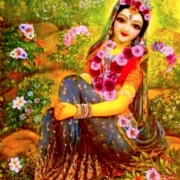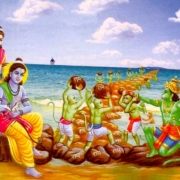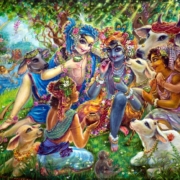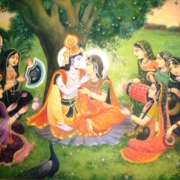Suddha nama – Descent & Perspective
Mahanidhi Madan Gopal Das
Pure name (suddha-nama) is the result of a state of consciousness, which is completely devoid of other desires (anyabhilasita sunyam). The name of Kṛṣṇa that is chanted with wholehearted devotion and unalloyed love is the true name of Kṛṣṇa. Anything else is but a semblance of the name (namabhasa) or the utterance with offense (nama-aparadha).
The internal competence (adhikara) of the person chanting the holy name is the main factor. Only a surrendered soul saturated with devotion can utter the actual holy name. Similarly, to what degree a hearer can perceive the actual name is dependent on the depth of his devotion. The appearance of the holy name in this world is a matter of divine descent and internal personal perspective.
Chanting the pure name is never a mechanical act that a skillful speaker with correct intonation can evoke. The ability to chant suddha-nama is an act of divine grace bestowed upon those devotees who have saturated their minds and hearts with devotion. Whether or not there is a manifestation of the divine through matter is dependent on the spiritual strength of the person chanting the holy name. This principle of spiritual competency is an important feature of Srila Bhaktivinoda Thakura’s teachings.
When one is free from anarthas and aparadhas, suddha-nama, which is Kṛṣṇa Himself, descends into one’s heart from Vraja Gokula. Suddha-nama appears with the descent of suddha-sattva, which is the personal divine potency (svarupa-sakti) of Sri Kṛṣṇa that also resides in the hearts of Kṛṣṇa’s eternal associates. Suddha-sattva or svarupa-sakti is a combination of two other spiritual energies called samvit-sakti (divine wisdom) and hladini-sakti (divine love and bliss). Generally the svarupa-sakti passes from the heart of one or more of Kṛṣṇa’s eternal associates into the heart of a sadhaka.
At the stage of suddha-nama one no longer commits any aparadha. The holy name is chanted only for kṛṣṇa-prema. There is no other desire in the heart except acting for the pleasure of Kṛṣṇa. Suddha-nama is the pefectional stage of chanting where a devotee sees Kṛṣṇa personally dancing on his tongue. By such pure chanting one realizes his spiritual form and attains the goal of kṛṣṇa-prema. Acaryas confirm that when suddha-nama appears, the Divine Couple dance together on the “rasa-mandala” tongue of the pure devotee.
“The holy name of the Lord and the Lord are nondifferent; therefore when a devotee chants Hare Kṛṣṇa, Kṛṣṇa and His internal potency (Radharani) are dancing on the tongue of the devotee.” (Bg 12.8 p.)
“As soon as we get advanced in the chanting of Hare Kṛṣṇa Hare Kṛṣṇa Kṛṣṇa Kṛṣṇa Hare Hare, then we shall gradually realize that actually God is with us. God is dancing on my tongue in the form of sound. You see?” (SPT 25/5/66)
Unfortunately the name that is generally chanted is something less than suddha-nama known as a semblance of the name (namabhasa) or the name chanted with offense (nama-aparadha).
An excerpt from the book Art of Chanting.









Leave a Reply
Want to join the discussion?Feel free to contribute!